
Making smart investment choices is a great way to build wealth and create financial freedom. However, it is a journey that requires careful planning and discipline. Before investing, it is crucial to assess your personal circumstances, including your financial goals, time horizon, risk tolerance, and cash flow. Understanding your risk appetite and having a solid grasp of your regular cash flow will help you make informed decisions and maximize your returns over time. Diversifying your portfolio by investing in a range of companies across different industries is also a wise strategy to reduce risk. It is important to base your investment decisions on logic and systematic analysis rather than emotions or rumors. Additionally, being aware of and accepting the uncertainty of the market is crucial, as there are no guarantees, and various circumstances can impact your investments. Successful investing involves making choices that meet your unique needs and financial goals, whether they are short-term or long-term.
| Characteristics | Values |
|---|---|
| Financial goals | Short-term (e.g. holiday, car), medium-term (e.g. house, child's education), long-term (e.g. retirement) |
| Time horizon | How much time you have to invest to meet your financial goals |
| Risk profile | Risk tolerance, risk-taking capacity |
| Emotional factors | Sticking to the plan |
| Life changes | Expect the unexpected |
| External factors | Inflation levels, economic cycles, geopolitical risk |
| Savings | Save 20% of your income for emergencies |
| Diversification | Diversify your portfolio |
| Investment knowledge | Understand the market, analyse and weigh up factors |
| Investment time horizons | Align your investments with your time horizons |
What You'll Learn

Understand your risk appetite
Understanding your risk appetite is a crucial step in making smart investment choices. Risk is an inevitable part of investing, and different investments carry different levels of risk. Before investing, it's important to assess your risk tolerance, which is influenced by factors such as your age, income, wealth, and the number of dependents you have. Being honest with yourself about your risk appetite will help you make informed investment decisions.
When considering your risk appetite, it's essential to distinguish between risk tolerance and risk capacity. Risk tolerance refers to your emotional and psychological comfort with taking risks, while risk capacity is a more objective assessment of your ability to take on risk. For example, a young investor with a high income and no dependents may have a higher risk capacity and could potentially take on more risk to achieve higher returns. On the other hand, a conservative investor with a low-risk tolerance may prefer to avoid riskier investments, even if they have the capacity to take them on.
It's important to note that higher risk does not always mean higher returns. While taking on more risk can offer the potential for greater rewards, it's crucial to find a balance between risk and reward that aligns with your investment goals and time horizon. Diversifying your portfolio by investing in a range of assets and industries can help manage risk and protect against potential losses.
Additionally, it's essential to consider the impact of market volatility on your investments. Even the wisest investments can be affected by various circumstances and events, and there is no guarantee that your investments will perform as expected. Understanding and accepting this uncertainty is crucial when investing in the market.
By assessing your risk tolerance, capacity, and appetite, you can make more informed investment decisions that align with your financial goals and comfort level. This will help you stick to your investment plan and avoid making impulsive decisions based on emotions or external influences.
National Savings and Investments: A Secure Financial Future
You may want to see also

Diversify your portfolio
Diversifying your portfolio is one of the smartest decisions you can make as an investor. It is a way to reduce risk and increase potential returns over time.
A diverse portfolio means that your investments are spread across a wide range of investment types. For example, if you are investing in stocks, it is less risky to invest in a variety of companies across different industries, rather than putting all your money into one company or industry. That way, if one of your investments doesn't perform as expected, you have others to cushion the financial blow.
Diversification is a risk management strategy. For instance, during the economic instability caused by the Covid-19 pandemic, investors with diversified portfolios fared much better than those who had concentrated their money into one kind of stock.
A diversified portfolio typically holds a combination of savings, income, and growth investments. It is important to note that lower risk typically means lower returns, while taking more risk is likely to offer better returns over time.
When building a diversified portfolio, it is also important to consider your investment time horizon. If you are investing for the long term, you may want to include a growth component in your portfolio. On the other hand, if you are investing for the short term, you should consider more conservative and more accessible investments.
It is also crucial to monitor your portfolio regularly to ensure that it continues to meet your needs and financial goals. Market conditions, life events, and changing goals are all cues to review and rebalance your portfolio.
Encouraging Corporations to Invest in Green Energy
You may want to see also

Understand the uncertainty
Investing is a great way to build wealth and create financial freedom for yourself. However, it is important to understand that the market is uncertain and there is no 100% guarantee on what will happen to your investments. Here are some key considerations to help you understand and navigate the uncertainty:
Accept the Uncertainty
When investing, it is crucial to acknowledge and accept the inherent uncertainty in the market. No matter how wise or promising an investment may seem, circumstances can change rapidly and impact the value of your investments. From economic downturns to geopolitical events, many factors beyond your control can influence your investment's performance. This uncertainty is an inevitable aspect of investing, and it's important to be prepared for both positive and negative outcomes.
Understand Market Volatility
The value of your investments can fluctuate due to market volatility. Market volatility refers to the ups and downs of the stock market over time. It is influenced by various factors, such as economic conditions, interest rates, company news, and investor behaviour. Understanding market volatility can help you make more informed investment decisions and manage your expectations. Diversifying your portfolio across different asset classes and industries can help reduce the impact of volatility on your investments.
Long-Term Perspective
While short-term market fluctuations can be unnerving, it's important to maintain a long-term perspective. Historical trends show that, over time, the stock market tends to increase in value. By focusing on long-term goals and staying invested through market cycles, you can ride out short-term volatility and potentially benefit from compound interest and capital growth.
Risk Assessment
Different investments carry different levels of risk. It is essential to assess your risk tolerance and understand the potential risks associated with each investment. Consider factors such as your financial goals, time horizon, and personal circumstances when evaluating risk. While taking on more risk may offer the potential for higher returns, it's important to ensure that the level of risk aligns with your investment strategy and comfort level.
Stay Informed
Staying informed about market trends, economic conditions, and industry news can help you make more informed investment decisions. Regularly review your investment portfolio and monitor any changes in the market that may impact your investments. This proactive approach can help you identify potential risks and opportunities and make any necessary adjustments to your investment strategy.
Diversification
Diversifying your investment portfolio is a crucial strategy to navigate uncertainty. By spreading your investments across different asset classes, industries, and geographic regions, you can reduce the impact of any single negative event. Diversification helps to lower overall risk and increase the potential for long-term returns. It ensures that your portfolio is not overly exposed to any specific risk factor and can provide a buffer during market downturns.
In summary, understanding and accepting the uncertainty in the investment market is crucial for making smart investment choices. By acknowledging market volatility, maintaining a long-term perspective, assessing risk, staying informed, and diversifying your portfolio, you can enhance your investment strategy and potentially increase your chances of success. Remember, investing is a journey, and by navigating the uncertainty effectively, you can work towards achieving your financial goals.
Understanding Investment Management: The Distribution Factor
You may want to see also

Know your financial goals
Knowing your financial goals is the first step to making smart investment choices. These goals will be unique to your personal circumstances, including your age, income, and life stage. Financial goals can be short-term, such as saving for a holiday, a new car, or an emergency fund, or medium-term, such as saving for a house or your child's education. They can also be long-term, such as investing for retirement.
Once you have identified your financial goals, it is important to write them down clearly and create an investment roadmap. This roadmap will guide your investment decisions and help you track your progress. It should include your long-term and short-term goals, financial priorities, and plans.
For example, if your goal is to save for retirement, you will need to consider the time horizon, or how much time you have until retirement. If you are closer to retirement, you may want to invest in products with lower risk, such as government or corporate bonds. On the other hand, if you are further away from retirement, you may be able to invest in higher-risk products, such as stocks or shares, as you have more time to recover from any market fluctuations.
Another factor to consider is your risk tolerance and capacity. How much risk you are willing to take will depend on your age, income, wealth, and number of dependents. It is important to be honest with yourself about your risk appetite, as taking too little risk may result in lower returns, while taking too much risk can lead to financial losses.
Understanding your cash flow is also crucial when setting financial goals. You need to know how much income you are bringing in each month and how much you are spending on expenses to effectively plan your savings and investments.
Finally, it is important to remember that investing is a journey. Your financial goals may change over time, and you should regularly review and adjust your investment plan accordingly.
Crafting Investment Recommendation: Webster's Guide
You may want to see also

Monitor your portfolio
Monitoring your portfolio is an important step in making smart investment choices. Here are some detailed guidelines to help you monitor your portfolio effectively:
- Regular Review: It is recommended to review your investment portfolio at least once a year. This can be done with the help of a financial advisor or independently. Regular reviews ensure that your portfolio remains aligned with your financial goals and changing circumstances.
- Market Conditions: Keep an eye on market conditions and trends. The performance of your investments is influenced by economic cycles, interest rates, and geopolitical events. Stay informed about these factors to make timely adjustments to your portfolio.
- Life Events: Consider significant life events, such as marriage, having children, or retirement, as cues to review your portfolio. These events often come with financial implications that may require adjustments to your investment strategy.
- Goal Setting: Periodically assess your short-term and long-term financial goals. Ensure that your portfolio is helping you work towards these goals. Adjust your investments as your goals evolve over time.
- Risk Assessment: Regularly evaluate your risk tolerance and comfort level. As your circumstances change, your capacity for risk may also fluctuate. Adjust your portfolio to match your current risk appetite and financial situation.
- Performance Evaluation: Analyse the performance of your investments over time. Track their growth and returns, comparing them to market benchmarks and your expectations. This will help you identify areas of strength and weakness in your portfolio.
- Rebalancing: Based on the performance evaluation, consider rebalancing your portfolio. This may involve buying or selling assets to ensure your investments remain diversified and aligned with your goals. Remember that diversification can help reduce risk and improve long-term returns.
- Seek Expert Advice: Consult financial advisors or experts when needed. They can provide valuable insights and guidance tailored to your specific circumstances. Their knowledge can help you navigate complex investment decisions.
By diligently monitoring your portfolio, you can ensure that your investments remain on track with your financial goals and adapt to changing market conditions and personal circumstances. This proactive approach will help you make informed decisions and improve your chances of achieving your desired investment outcomes.
Private Equity Investment Options: Exploring LLC Opportunities
You may want to see also
Frequently asked questions
Investing is a great way to build wealth and create financial freedom. It helps you create an additional source of income, provides long-term financial security, and helps create sufficient post-retirement wealth.
It is recommended to save 20% of your income to build an emergency fund equal to roughly three to six months' worth of ordinary expenses. You can invest any additional funds that aren't needed for near-term expenses.
Before investing, assess your personal factors: your financial goals, time horizon, risk tolerance, ability to deal with market volatility, and preparedness for emergencies. Also, consider external factors like economic cycles, governmental moves, and geopolitical risks.
A:
- Start investing early and consistently.
- Understand your risk appetite and cash flow.
- Diversify your portfolio to reduce risk and increase potential returns.
- Don't underestimate the power of compound interest.
- Avoid making decisions based on emotions and rumours.







